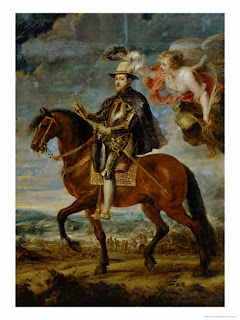Wednesday, March 31st, 2010
Kehinde Wiley and His Inspiration
I love when contemporary artists use historical art for inspiration. Kehinde Wiley is one such artist, who often creates portraits of African-American men in poses that mimic specific portraits from the 17th-19th centuries. Since Wiley’s portraits show African-American in the latest hip hop street fashion, the portraits provide interesting commentary on fashion, identity, and propaganda. It’s also interesting to see how issues of identity (and the creation of identity via portraiture) have existed for centuries, especially when examining the historical paintings which inspired Wiley. Here are two of my favorite Wiley paintings (and the paintings that inspired them):

Kehinde Wiley, Prince Tommaso Francesco of Savoy-Carignano, 2006
See the portrait which inspired Wiley below:
Anthony Van Dyck, Prince Tommaso Francesco of Savoy-Carignano, 1634
Kehinde Wiley, Equestrian Portrait of Philip II, 2009
This portrait by Wiley is a little different, in that he doesn’t depict Michael Jackson wearing hip hop street clothes. Jackson actually commissioned this portrait in 2008, but never saw the completed work. J thinks that the inclusion of the cherubs (instead of the angel in the Ruben’s painting which inspired Wiley, as shown below) is fitting, given that Jackson was accused of sexually abusing children. I really doubt that Wiley intended to make that reference, but it’s an interesting thought. The painting was finished after Jackson’s death in 2009 and sold that same year to German collector for $175,000. My favorite thing about this portrait is that it depicts Jackson at the height of his career. I think the armor and pose totally scream “I’m bad, I’m bad, you know it!” Man, you can’t help but love MJ’s early stuff. He was the Prince of Pop, and a royal equestrian portrait is fitting. Anyhow, you can read more about this portrait here and here.
Rubens, Philip II on Horseback, c. 1628-29
I have to admit, I think Rubens has created a lot more powerful horses than the one in this painting. Wiley’s horse has a lot more presence than the one shown here. Maybe the puny horse accounts for why this portrait is not very well-known. Anyhow, if you’re interested, the Prado Museum has some discussion about the restoration of this portrait here.
You can see more of Wiley’s work on his website and read a little bit more about him on this page of the National Portrait Gallery’s site. What do you think of Wiley’s portraits? Do you think they raise interesting questions about identity and personal image?
(e, do you remember when you saw L L Cool J’s portrait by Wiley (2005) in the NPG? I found out this evening that both L L Cool J and Wiley wanted the portrait to recall John Singer Sargent’s portrait of Rockefeller (1917). Pretty cool, huh? Who would have guessed that L L Cool J was familiar with Sargent? Even though I think the green and red pattern in the Wiley portrait is a a little too visually aggressive, I love that the painting recalls a Sargent portrait.)



Very cool. I like how he places his subjects in direct line with past powerful people, but at the same time keeps it feeling modern by flattening the picture plane. Love the LL Cool J portrait.
quite fascinating, thanks for the introduction! pgt
I'm so glad you did this post.
I have to admit that after reading your post I have a whole new respect for the (very) loud portrait of LL Cool J at the NPG. I walked past it again the other day and, after I got over the residual blindness caused by the colors, enjoyed looking at it.
It is very interesting that Wiley can use such classical art and make it work for a younger, specific audience. It's very cool.
Are you surprised about how much the Michael Jackson painting went for? I don't know a lot about the prices of art, but it seems like it should be worth more??
And I really think it is very cool that both Wiley and LL Cool J picked the Rockefeller painting. It's interesting to see how an older, maybe even stiff painting, can become the model for something so fresh.
I'm afraid I have to agree with J about the replacement of the angel with cherubim. It is a pretty conspicuous change.
This is a very interesting approach. I am not all that convinced by the work, though.
Having visited the exhibition on Picasso & ses maîtres, as well as the copycat Turner exhibition, I am convinced it is possible to produce more interesting original work that derives from past masterpieces.
http://davidikus.blogspot.com/
I thought I was brilliant when I inserted my face into a Dutch Baroque portrait in my drawing class, prior to ever knowing his work. When I showed it in class, however, my classmates asked if it was Prince William. Ummm, not exactly what I was going for.
Oh yeah, and I did see the HIp Hop exhibition at the National Portrait Gallery with some of his work. That's when I got really excited about him.